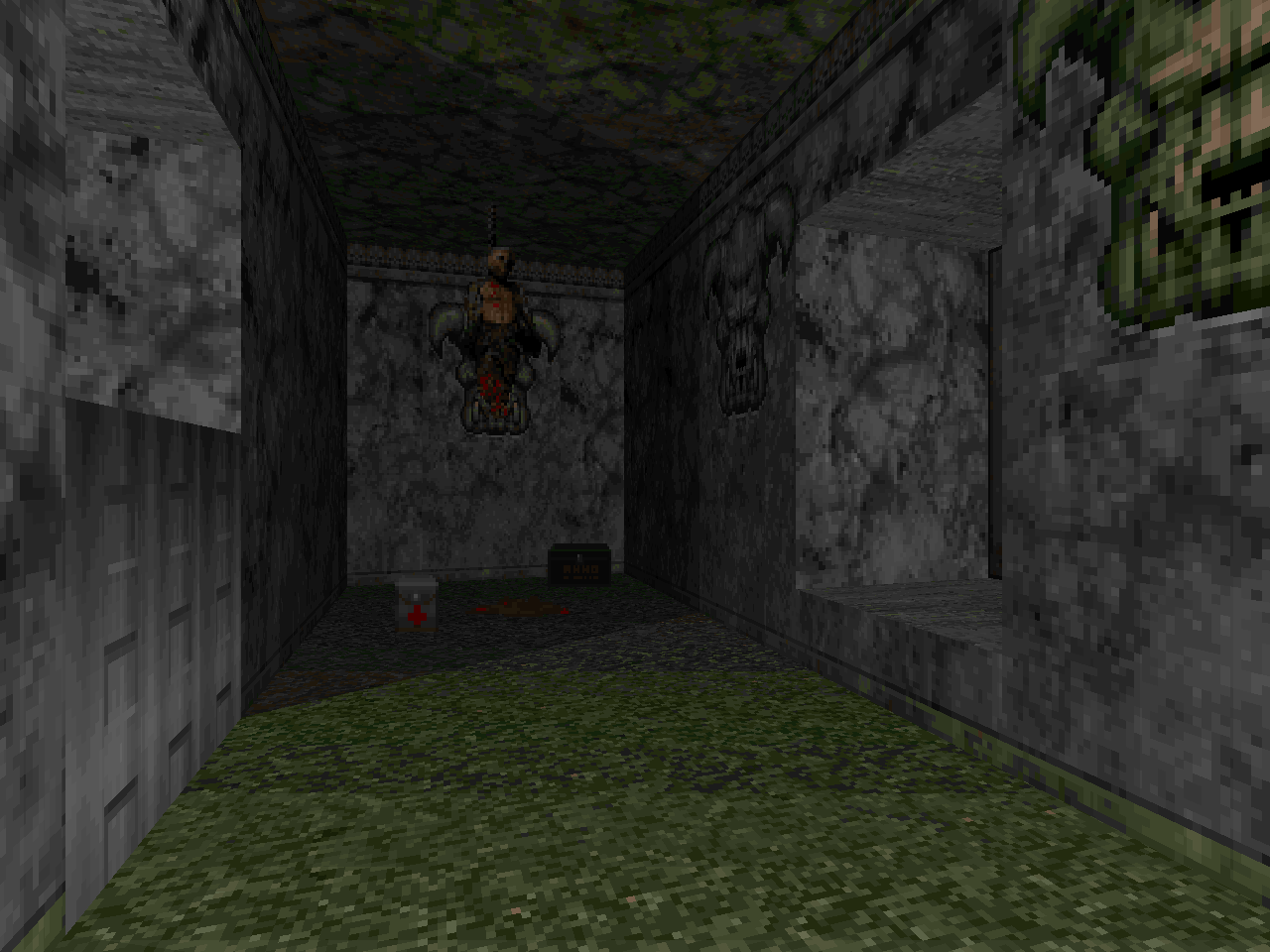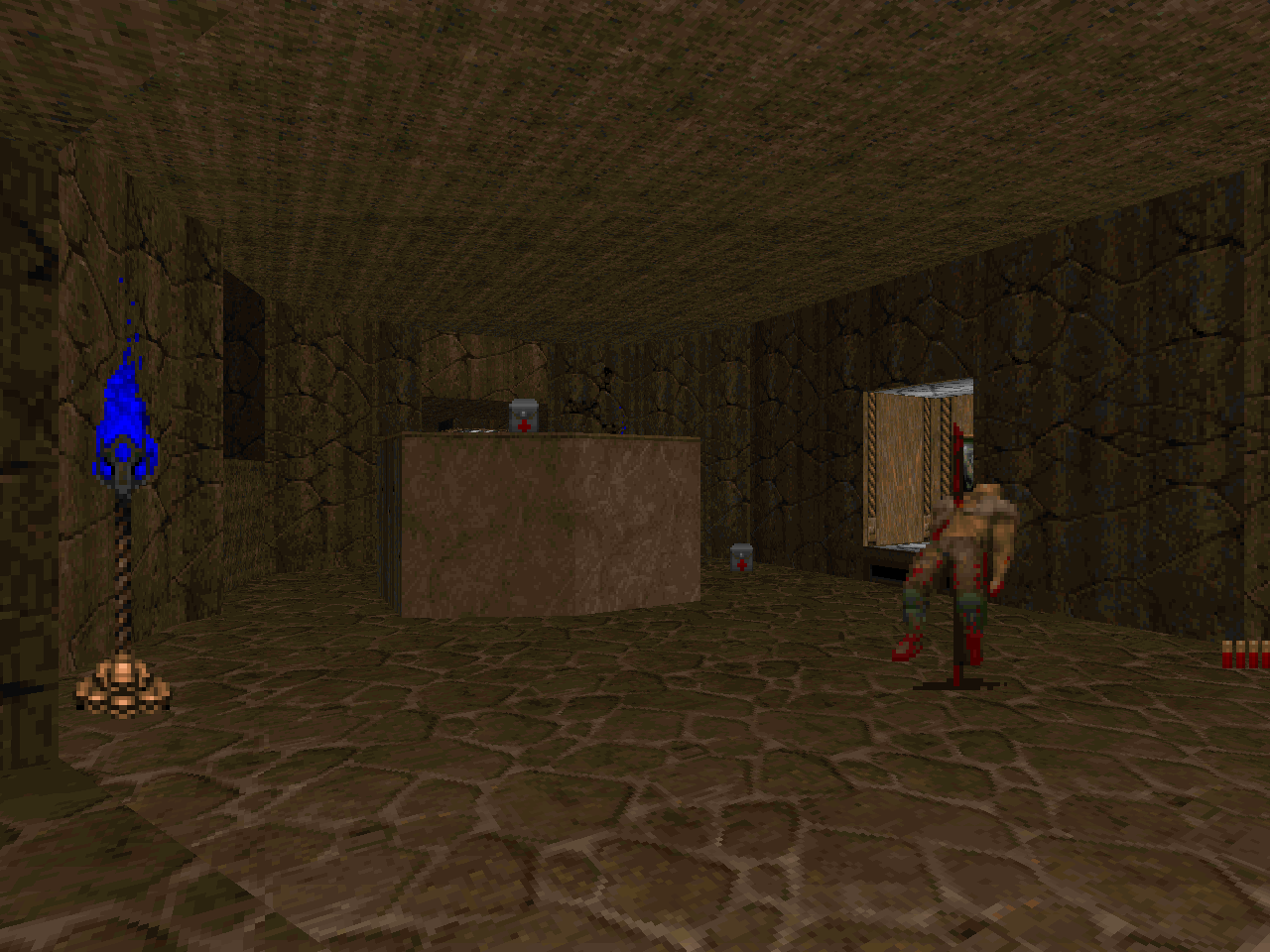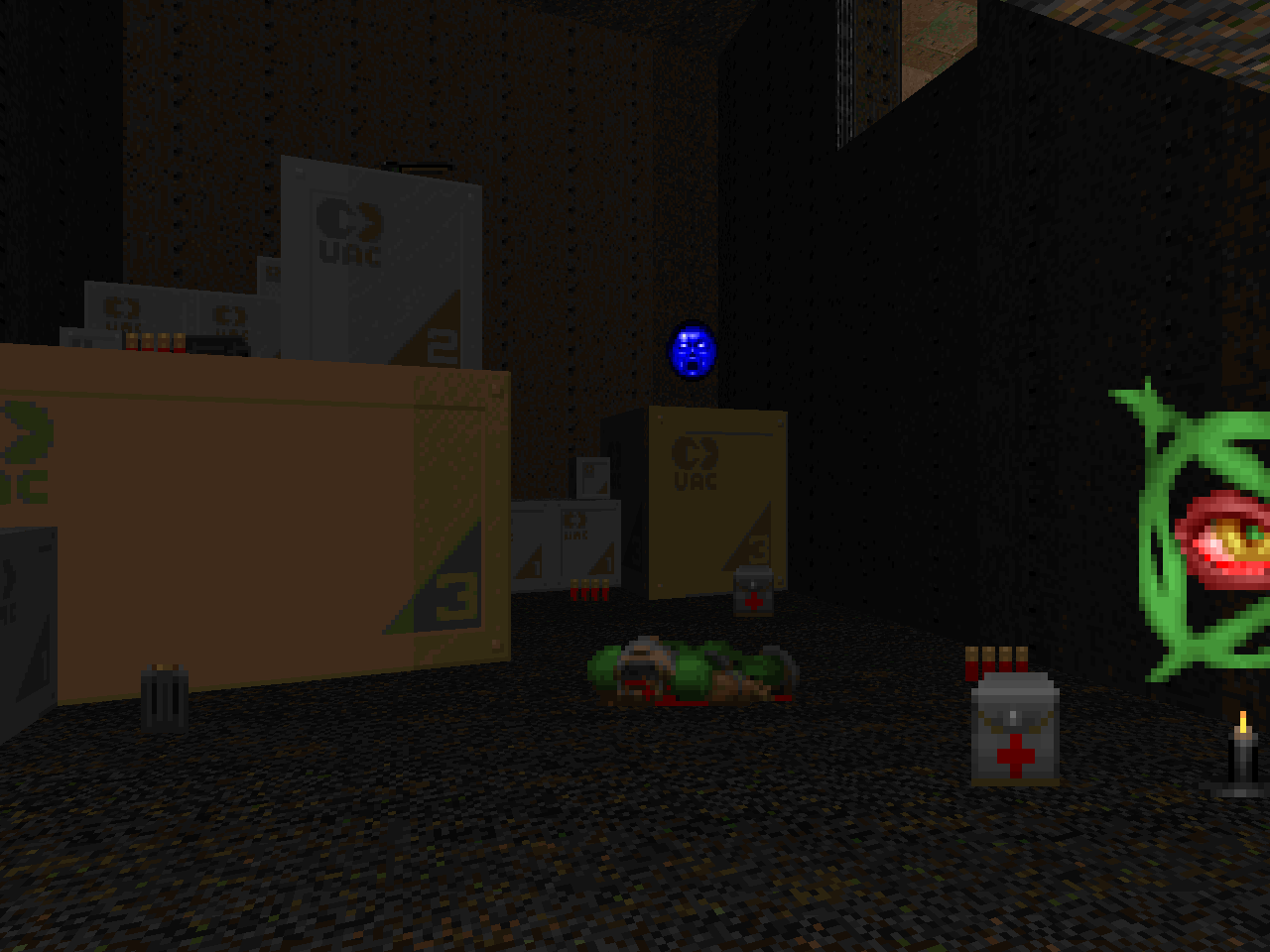SIMPHONY OF DEATH
by "Sphagne"
Some corrections are in order. A handful of authors for the original Community Chest submitted previously published works: Daniel Trim (Redux), Gene Bird (Blind Alley), and Sphagne. Back when I started really digging into the CCHEST contributors I was pretty sure that Sphagne's offerings were part of a broader, unfinished series, much like Blind Alley or Alex Parsons's World's End. As I read through these .TXTs, however, I realized that the sequence numbers given to the maps are only presented to establish the order in which they were created in 1995-1999. Presumably a significant portion of these levels remain unreleased. Mothership was the author's 19th chronological creation and with fourteen available on the archives (one of which is Deathmatch only) that leaves five unaccounted for. This review is for the first of Sphagne's published levels but the second overall: Simphony of Death. Created at an undisclosed time in the mid-to-late '90s (presumably 1995), it was uploaded to /idgames alongside the rest of his levels in August of 2002 and is a MAP01 replacement for Doom II.
I assumed that Sphagne's levels were part of a broad cycle because he intimated the order of their creation. In retrospect, his plots are either a collection of unassociated vignettes or the central character is the most interesting person in the universe, with a lineage that can be traced to the Greek goddess, Artemis. An apocryphal child of Orion, perhaps? Simphony of Death has virtually no framing narrative, more of a teaser of the most iconic structure / encounter of the level. The author establishes that the level possesses an enormous theater where a Cyberdemon is conducting an organic orchestra. The .TXT hints that you must get the monsters to perform for you before playing your solo.
I don't know where the following twelve levels are going to go but I really enjoyed Sphagne's style as it appears here. #SYMPHOD is a sprawling map whose opening segments consist of a network of tunnels and caverns with all sorts of complex, timed-lift and door sector machinery. The cramped spaces do little to prepare you for the scale of the monolithic theatre that sits in the level's center... but you are offered a few good glances via windows. The same logic also applies to many of the map's secrets, some of which grant passage to considerable side areas. At least one appears to rely on using the vertical deviation from your more unfocused hitscan attacks to trigger switches.
The author also did a lot of work to make the orchestral platforms difficult to navigate. The central arrangement of the chamber is like a concert hall with bleacher seating fit for giants. The height rises upward and away from your initial entrance point. Which is, uh, right behind the conductor's platform. I will admit that the setup does a good job of fostering infighting between the Cyberdemon and its orchestra. There is still some trial and error involved in figuring out how you are to explore the level from here, however, and the fact that ol' mobile rocket launcher can turn on you at any moment is unsettling. This is also why the "curtain raising" effect that kicks things off is easy to miss.
From here the player can either try to explore the Cyberdemon's ledge or just jump down into the orchestra pit. Both routes eventually take you to the same destinations but the latter is just as dangerous as the only way out of the cesspool consists of opposed teleporters that take you to the not-quite-top of the tiered platforms. From here you will have to cascade down through the instruments of destruction. Toward the bottom of these musical stairs you will find the blue key as well as opposed elevators. The lifts access alcoves that sport blue key doors as well as teleporters. The portals take you to a pair of rooms that are... accessed via the Cyberdemon ledge that you started out on.
Routing through the central area - and how it all connects to the level's periphery - constitutes its biggest navigational challenge. Once that's sorted out, the areas beyond the blue - and yellow - key doors are much simpler to figure out. The outer region circumscribes the symphony from the northwest corner to its mid-south. There is a sawtooth map flow design that is similar to the auditorium in that the eastern path is only accessible from the south and is also the only way to get to the red key that is prominently displayed in the north. It's interesting to see one-way routes used so prominently in a level; I wonder whether they will figure into Sphagne's future works.
Playing Doom is more than traversing tricky layouts, though. While you are attempting to master the pneumatic and gated progression you will be subject to constant surprise attacks by monsters as well as several massive, pitched battles. The title tussle sticks out not only due to its scope and size of the playing field but also due to its unusual setup. The character of combat of the western area features tricky, small-scale fights with most of the beasties with lower space profiles. Hopefully you are adept at handling revenants in tighter confines. Most of the fighting in the outdoor segment is concentrated in the northern section. It's a sprawling if not necessarily wide-open battleground. More importantly, it's subject to a multi-prong teleporter ambush that restocks monsters in defensible positions. This is in addition to its initial, hornet's nest-style placement. I ought to note, however, that only completionists are obligated to deal with the final wave.
#SYMPHOD is a pretty good-looking level for something that was designed in 1995. I suppose that the overall theme is more representative of the wild-ass era of individually cohesive rooms as opposed to a texture scheme that's consistent across the entire level. Given the mix of marble and metal and UAC computer screen stuff it feels more like a kitchen-sink map representative of a blending of realities between Hell and Earth. I dunno what if any touching-up Sphagne did for release but the orchestra room is a wicked cool piece of early macrotecture and some of the minor set-pieces, like the bloodfall area, make for neat little vignettes. In spite of the sort of disorganized funhouse opening, the auditorium and outdoor area do a good job of grounding the level as you play on. Looking back, the overall story of the map is more like an operative who has infiltrated an infested UAC base in order to investigate an amassing demon army, afterward escaping out the front door.
I really enjoyed Simphony of Death but I imagine that it appeals to a more niche audience than your average Doom II level. Progression of the level demands more from the player's intuition and is on the whole a more cerebral exercise. This goes especially for its opening bit-by-bit dungeon exploration, feeling more like a smaller-scale execution of the principles that guided Kevin Reay's level design in Industrial. #SYMPHOD's big centerpiece encounter serves as a confounding factor as the moving parts serve as a potent distraction while the player tries to mentally map everything together. Furthermore, the author depends on the player's temperament to not become immediately frustrated upon entering the northern section and finding the red key inaccessible. Provided, of course, that one doesn't simply "cheat" in a modern source port and jump up on the platform.
I have no idea what to expect from the original Community Chest but I can tell from my perusal of so many of its authors' collected works that it will be my kind of megaWAD. As I continue to play through his catalogue, I'm interested in seeing whether Sphagne deviates from the style that he has executed in Simphony of Death. If you're into the complex layouts of mid-to-late '90s maps, or just want to see a Cyberdemon conduct a techno-organic orchestra, then you should give this one a look.

OSTINATO 3:16 SAYS
I JUST WHOOPED YOUR ASS










No comments:
Post a Comment